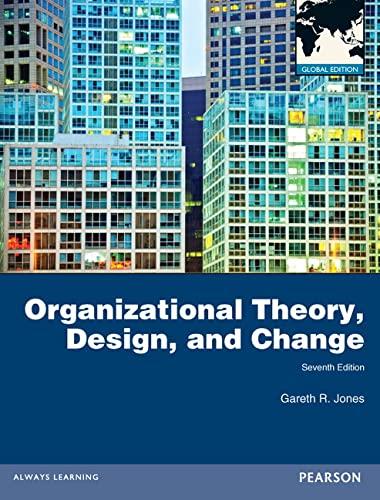It may be surprising to some observers to find out that the Royal Mail Group is still
Question:
It may be surprising to some observers to find out that the Royal Mail Group is still one of the largest organizations in the UK. It now consists of Royal Mail itself, which concentrates on the letter and small packet business by utilizing 60 mail centers, 8 regional distribution centers, and 1,400 local delivery offices. Post Office Counters is also part of the Royal Mail Group and still boasts a network of 12,000 branches throughout the UK. Parcelforce Worldwide, the group’s parcel brand, is still a significant player in a highly competitive sector, and General Logistics Systems is Royal Mail’s European parcel company.
The organization has not, however, always been in this form.As a nationalized business and later as a PLC wholly owned by the government, Royal Mail has had to contend with a succession of differing government reviews and policies and the loss of its prized letter delivery monopoly in 2006. An additional problem has been Royal Mail’s industrial relations record, which, over the years, could be described as difficult to say the least.
The Internet also posed highly significant challenges to the business. A sharp reduction in social mail accompanied the rise of email, although the greeting card business has held up well. The Internet did however provide an opportunity for Royal Mail and Parcelforce to deliver a growing number of items sent out by Internet retailers such as Amazon.
Post Office Counters has faced structural decline of a different type. It has also been hit by a decline in demand for letter post services, but more significantly it has ceded much of its role as an agent for paying pensions and child benefits as successive governments have tried to persuade customers to receive these payments through an electronic transfer system that is far less expensive to administer. Vehicle Licensing can now also be performed online. However, because of its heritage and presence in even the most remote parts of the country, it has been seen as a community service as well as a profit making enterprise. Consequently, politicians have often argued a case for keeping Post Offices in remote villages even if Post Office regional management have felt that it was not viable to do so.
Understandably, managing a group of this size has posed some major challenges in terms of designing organizational structures. BT was, in fact, originally part of the Post Office under the name Post Office Telecommunications and gained their own identity only in 1981. Subsequently, Royal Mail operated as a highly bureaucratic organization encompassing letter and parcel delivery and Post Office counter functions. There was a low degree of specialization and a high degree of multi-skilling in some parts of the organization, for example, administrative staff could expect to serve on the counter and also work in the back office functions of Royal Mail. Sorting Office staff could also be trained on a variety of roles concerning sorting, distribution, and delivery of mail. A set of Post Office rules was available in several large volumes to consult in the case of almost any eventuality. In addition, there was a Postmaster/Postmistress in every city who took overall responsibility for the operation of the services within his or her district..........
Discussion Questions
1. Why did Royal Mail implement the “Business Development” process?
2. Post Office Counters have pursued a policy of increasing the number of Post Offices run autonomously by Sub-Postmasters or Sub Postmistresses. Is this a form of centralization or decentralization? Explain your answer.
Step by Step Answer:

Organizational Theory Design And Change
ISBN: 9780273765608
7th Global Edition
Authors: Gareth R. Jones





